中考英语 倒装句考点详解与精练
完整版初中英语倒装句讲解及练习(1)

完整版初中英语倒装句讲解及练习(1)完整版初中英语倒装句讲解及练习一、倒装句的定义倒装句是指把主语或其它成分放在谓语之前的句子。
二、倒装句的分类1. 全部倒装:把全部谓语动词放在主语的前面。
例如:Never have I seen such a beautiful sunset.2. 部分倒装:把助动词、系动词或情态动词放在主语前,并把它和谓语之间调换位置。
例如:He can speak English, so can his sister.3. 省略倒装:省略掉了连接词的部分倒装。
例如:Here comes the bus.三、倒装句的使用倒装句一般用于以下情况:1. 为了强调句子的某个内容。
例如:In the classroom were the students waiting for the teacher.2. 形式固定的句子。
例如:Not only did he study English, but he also learned French.3. 当句首是副词、介词短语或者表示地点,时间和方式的词组时。
例如:On the wall hangs a picture.4. 在虚拟语气中使用。
例如:Had I known the answer, I would have told you.四、练习1. ________ you ever been to Beijing?A. haveB. HasC. DoD. Did答案:A解析:把 have 放在句首进行倒装。
2. Only in this way ________ the problem.A. can we solveB. we can solveC. solved we canD. do we solve答案:A解析:把助动词 can 与主语 we 调换位置。
3. Hardly ________ when it began to rain.A. I had left homeB. had I left homeC. I left homeD. left I home答案:B解析:把助动词 had 与主语 I 调换位置。
九年级英语倒装句X知识点总结及经典习题(含答案)

九年级英语倒装句X知识点总结及经典习题(含答案)一、倒装句1.-- He swam in the river this summer.-- ________A. So did he.B. So she did.C. So did she.【答案】 C【解析】【分析】“so+助动词(情态动词或连系动词)+另一主语”,此句型是主谓倒装结构,可以表示前面的情况也适用于后者,使用该句型需要注意以几个方面的问题:1.该句型只能用于肯定句,不能用于否定句:如果前句是否定句,则要用“neither /nor +助动词+主语”。
2.句型中的主语与上文中的主语是不同的两个主语3.句型中助动词,包括连系动词和情态动词的时态要和上句中谓语动词的时态相一致。
句意:这个夏天,他在这条河中游泳了。
她也游泳了。
结合语境可知前文情况也适用于后者,故用主谓倒装结构,选C。
【点评】这几个倒装句的区别比较难。
“so+助动词(情态动词或连系动词)+另一主语”,表示前面的情况也适用于后者。
So+主语+助动词(情态动词或连系动词)是对上文所说的情况加以肯定。
如果上文是否定形式则要将so换成neither。
2.— I think the plan is just a waste of time. What do you think?— Well, if you don't support the plan, ________.A. neither do IB. so do IC. neither will ID. so will I【答案】 C【解析】【分析】句意:——我认为这个计划只是在浪费时间。
您是怎么想的?——好,如果你不支持这个计划,我也不支持。
Neither+助动词+主语,表示主语也不是……;这里是if引导的条件状语从句,主句用一般将来时,从句用一般现在时态,这里是主句,故助动词用will。
根据题意,故选C。
【点评】考查倒装句,注意Neither+助动词+主语,表示主语也不是这样;so+助动词+主语,表示主语也是这样。
【英语】中考英语倒装句真题汇编(含答案)及解析
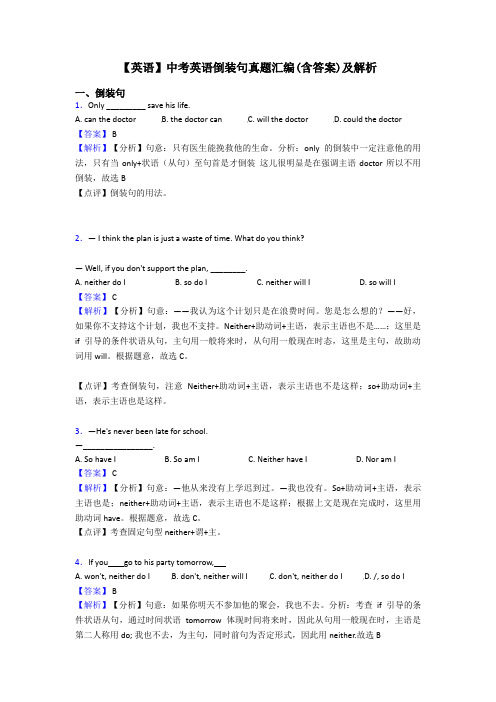
【英语】中考英语倒装句真题汇编(含答案)及解析一、倒装句1.Only _________ save his life.A. can the doctorB. the doctor canC. will the doctorD. could the doctor【答案】 B【解析】【分析】句意:只有医生能挽救他的生命。
分析:only的倒装中一定注意他的用法,只有当only+状语(从句)至句首是才倒装这儿很明显是在强调主语doctor所以不用倒装,故选B【点评】倒装句的用法。
2.— I think the plan is just a waste of time. What do you think?— Well, if you don't support the plan, ________.A. neither do IB. so do IC. neither will ID. so will I【答案】 C【解析】【分析】句意:——我认为这个计划只是在浪费时间。
您是怎么想的?——好,如果你不支持这个计划,我也不支持。
Neither+助动词+主语,表示主语也不是……;这里是if引导的条件状语从句,主句用一般将来时,从句用一般现在时态,这里是主句,故助动词用will。
根据题意,故选C。
【点评】考查倒装句,注意Neither+助动词+主语,表示主语也不是这样;so+助动词+主语,表示主语也是这样。
3.—He's never been late for school.—________________.A. So have IB. So am IC. Neither have ID. Nor am I【答案】 C【解析】【分析】句意:—他从来没有上学迟到过。
—我也没有。
So+助动词+主语,表示主语也是;neither+助动词+主语,表示主语也不是这样;根据上文是现在完成时,这里用助动词have。
2024年中考英语二轮专题复习之倒装句考点归纳讲义

2024届初中英语二轮专题复习之倒装句考点归纳倒装句是初中英语中的一个重要考点,它是指将谓语动词提前到主语之前的句子结构。
倒装句在语法上是一种常见的表达方式,常常用于强调、修辞等目的。
下面我们来总结一下倒装句的常见类型和用法。
一、完全倒装完全倒装是指将主语和谓语动词的位置调换,形成“主语+谓语动词+宾语”的结构。
例如:Not only the teacher but also the students were excited about the uping exam.The book that I borrowed from the library was very interesting.在这两个例子中,主语是“teacher”和“students”,谓语动词是“were excited”和“was”,宾语是“about the uping exam”和“the book”。
由于主语和谓语动词的位置被调换,形成了完全倒装的结构。
完全倒装常常用于强调、修辞等目的。
例如:The only person who could help us was the old man in the corner.在这个例子中,“the only person”是主语,谓语动词是“could help”,宾语是“us”。
由于主语和谓语动词的位置被调换,形成了完全倒装的结构,强调了“the only person”的重要性。
I am the one who has been working on this project for weeks.在这个例子中,“I”是主语,谓语动词是“am”,宾语是“the one who has been working on this project for weeks”。
由于主语和谓语动词的位置被调换,形成了完全倒装的结构,强调了“I”的作用和责任。
二、部分倒装部分倒装是指将助动词或情态动词提前到主语之前,形成“助动词或情态动词+主语+谓语动词”的结构。
人教版中考英语专项训练倒装句知识点梳理及经典练习(超详细)

人教版中考英语专项训练倒装句知识点梳理及经典练习(超详细)一、倒装句1.— I have never visited a paper factory.— .A. So have IB. I haven't nowC. Neither have I【答案】 C【解析】【分析】句意:-我从来没有参观过造纸厂。
-我也没去过。
根据句意可知这里表示的是否定的意思,故A可以先排除,因为so 的这个倒装的用法只能用在肯定句中,表示上面所说的情况也适用于另外一人。
在否定句应该用neither,当neither 位于句首时,应该用倒装的结构。
故选C。
【点评】考查倒装。
2.—He's never been late for school.—________________.A. So have IB. So am IC. Neither have ID. Nor am I【答案】 C【解析】【分析】句意:—他从来没有上学迟到过。
—我也没有。
So+助动词+主语,表示主语也是;neither+助动词+主语,表示主语也不是这样;根据上文是现在完成时,这里用助动词have。
根据题意,故选C。
【点评】考查固定句型neither+谓+主。
3.— Can you come to my birthday party, Lily?— If Jack does, ____________.A. so do IB. so I doC. so will I【答案】C【解析】【分析】句意:-Lily,你能来参加我的生日晚会吗?-如果Jack去,我就会去。
so do I我也是;so I do.我的确如此;so will I.我也将会。
句中if引导的是条件状语从句,从句中用一般现在时态,主句用一般将来时态,倒装结构表示上面说的情况也适用于另外一人,即我也会去参加。
故应选C。
【点评】考查倒装句。
4.—I didn't go to the cinema yesterday. What about you?—____________, because I was preparing for the project all the time.A. Nor do IB. Neither did IC. Neither am ID. Nor was I【答案】 B【解析】【分析】句意:—我昨天没有去电影院,你的?—我也没去,因为我一直在准备这个项目。
人教版中考英语九年级英语 必备英语倒装句技巧全解及练习题(含答案)
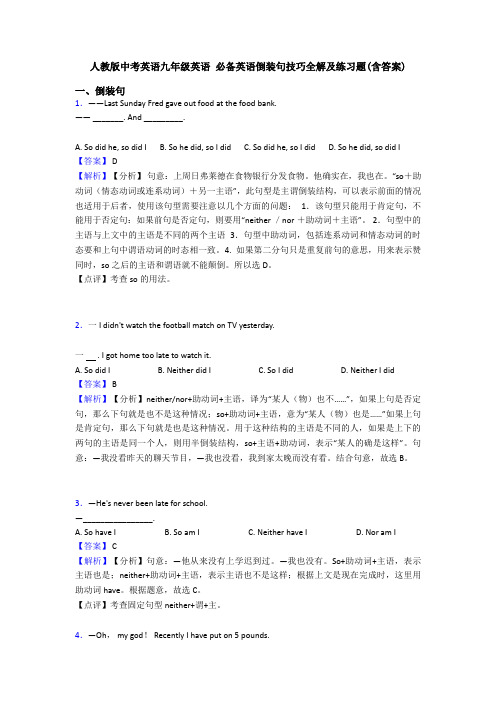
人教版中考英语九年级英语必备英语倒装句技巧全解及练习题(含答案)一、倒装句1.——Last Sunday Fred gave out food at the food bank.—— _______. And _________.A. So did he, so did IB. So he did, so I didC. So did he, so I didD. So he did, so did I【答案】 D【解析】【分析】句意:上周日弗莱德在食物银行分发食物。
他确实在,我也在。
“so+助动词(情态动词或连系动词)+另一主语”,此句型是主谓倒装结构,可以表示前面的情况也适用于后者,使用该句型需要注意以几个方面的问题:1.该句型只能用于肯定句,不能用于否定句:如果前句是否定句,则要用“neither /nor +助动词+主语”。
2.句型中的主语与上文中的主语是不同的两个主语3.句型中助动词,包括连系动词和情态动词的时态要和上句中谓语动词的时态相一致。
4. 如果第二分句只是重复前句的意思,用来表示赞同时,so之后的主语和谓语就不能颠倒。
所以选D。
【点评】考查so的用法。
2.一 I didn't watch the football match on TV yesterday.一 . I got home too late to watch it.A. So did IB. Neither did IC. So I didD. Neither I did【答案】 B【解析】【分析】neither/nor+助动词+主语,译为“某人(物)也不……”,如果上句是否定句,那么下句就是也不是这种情况;so+助动词+主语,意为“某人(物)也是……”如果上句是肯定句,那么下句就是也是这种情况。
用于这种结构的主语是不同的人,如果是上下的两句的主语是同一个人,则用半倒装结构,so+主语+助动词,表示“某人的确是这样”。
中考英语倒装句解题技巧讲解及练习题(含答案)
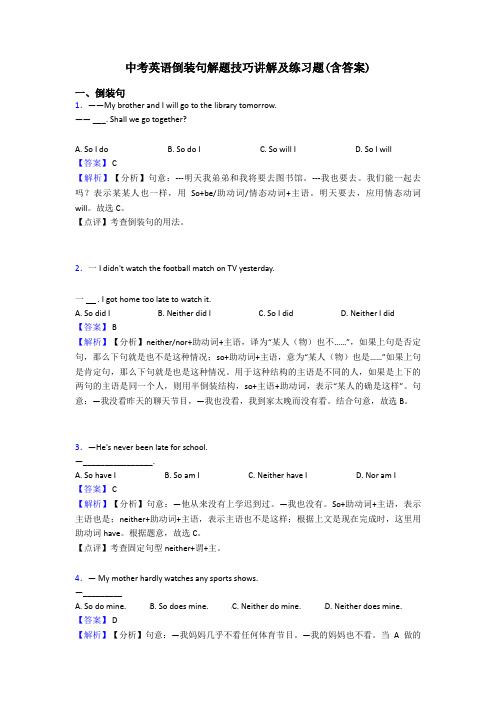
中考英语倒装句解题技巧讲解及练习题(含答案)一、倒装句1.——My brother and I will go to the library tomorrow.—— ___. Shall we go together?A. So I doB. So do IC. So will ID. So I will【答案】 C【解析】【分析】句意:---明天我弟弟和我将要去图书馆。
---我也要去。
我们能一起去吗?表示某某人也一样,用So+be/助动词/情态动词+主语。
明天要去,应用情态动词will。
故选C。
【点评】考查倒装句的用法。
2.一 I didn't watch the football match on TV yesterday.一 . I got home too late to watch it.A. So did IB. Neither did IC. So I didD. Neither I did【答案】 B【解析】【分析】neither/nor+助动词+主语,译为“某人(物)也不……”,如果上句是否定句,那么下句就是也不是这种情况;so+助动词+主语,意为“某人(物)也是……”如果上句是肯定句,那么下句就是也是这种情况。
用于这种结构的主语是不同的人,如果是上下的两句的主语是同一个人,则用半倒装结构,so+主语+助动词,表示“某人的确是这样”。
句意:—我没看昨天的聊天节目,—我也没看,我到家太晚而没有看。
结合句意,故选B。
3.—He's never been late for school.—________________.A. So have IB. So am IC. Neither have ID. Nor am I【答案】 C【解析】【分析】句意:—他从来没有上学迟到过。
—我也没有。
So+助动词+主语,表示主语也是;neither+助动词+主语,表示主语也不是这样;根据上文是现在完成时,这里用助动词have。
(完整版)倒装句全面讲解和练习(答案)

(完整版)倒装句全面讲解和练习(答案)初中英语倒装句(一)倒装句的意义1、适应一定的语法结构的需要,主要是指疑问句句型结构的需要。
E.g. Was the People’s Liberation Army founded in 1927?2、为了强调某一部分,而把这部分放到句首,构成倒装。
e.g. Never have I been late for school this term.(二)倒装的使用情况一、部分倒装:就是把谓语中的be动词、助动词或情态动词置于主语前面。
常见于下列几种情况:(一). only所修饰的副词,介词短语或状语从句放在句首时,要用:only+ 状语+ be /助动词/情态动词+主语及其他例如:Only when he told me the news did I know what had happened.注意:only修饰主语时,不需要倒装。
例如:Among all the people, only you know the truth.小试牛刀:Only in this way ________to make improvement in the operating system.A. you can hopeB. you did hopeC. can you hopeD. did you hope(二).含有否定意义的副词或连词放在句首时。
如:never, little, seldom, not, not only, not until, no sooner (…than), hardly (…when), rarely, scarcely, in no way等。
例如:We seldom get up at four in the morning.= Seldom do we get up at four in the morning.Not a single word from him could express his feelings.(1) hardly…when; scarcely…when…; no sooner…than… 可以用正常语序had hardly done when… did 或用倒装句式Hardly had +主语+ done when… did 句式。
中考英语语法之倒装句用法详解及练习分析
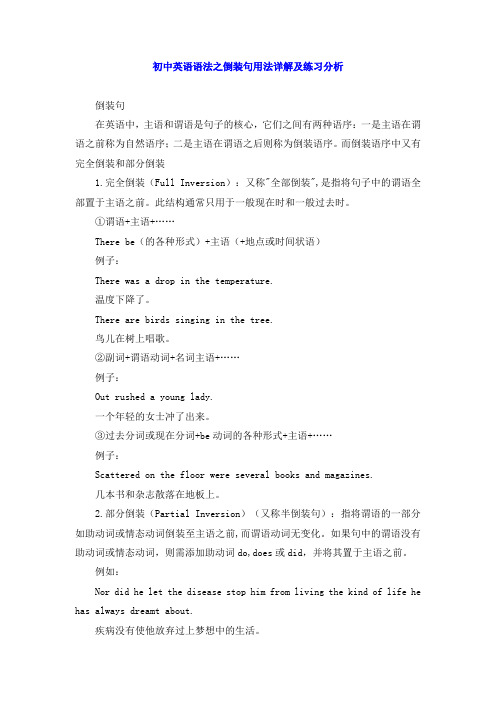
初中英语语法之倒装句用法详解及练习分析倒装句在英语中,主语和谓语是句子的核心,它们之间有两种语序:一是主语在谓语之前称为自然语序;二是主语在谓语之后则称为倒装语序。
而倒装语序中又有完全倒装和部分倒装1.完全倒装(Full Inversion):又称"全部倒装",是指将句子中的谓语全部置于主语之前。
此结构通常只用于一般现在时和一般过去时。
①谓语+主语+……There be(的各种形式)+主语(+地点或时间状语)例子:There was a drop in the temperature.温度下降了。
There are birds singing in the tree.鸟儿在树上唱歌。
②副词+谓语动词+名词主语+……例子:Out rushed a young lady.一个年轻的女士冲了出来。
③过去分词或现在分词+be动词的各种形式+主语+……例子:Scattered on the floor were several books and magazines.几本书和杂志散落在地板上。
2.部分倒装(Partial Inversion)(又称半倒装句):指将谓语的一部分如助动词或情态动词倒装至主语之前,而谓语动词无变化。
如果句中的谓语没有助动词或情态动词,则需添加助动词do,does或did,并将其置于主语之前。
例如:Nor did he let the disease stop him from living the kind of life he has always dreamt about.疾病没有使他放弃过上梦想中的生活。
部分倒装也有以下几种常见类型:1. 以否定词开头的句子要求部分倒装。
注意下列句子中助动词或情态动词提前、甚至补充助动词的用法:例:Not until yesterday did little John change his mind.小约翰直到昨天才改变了主意。
2024年中考英语冲刺复习知识点倒装句
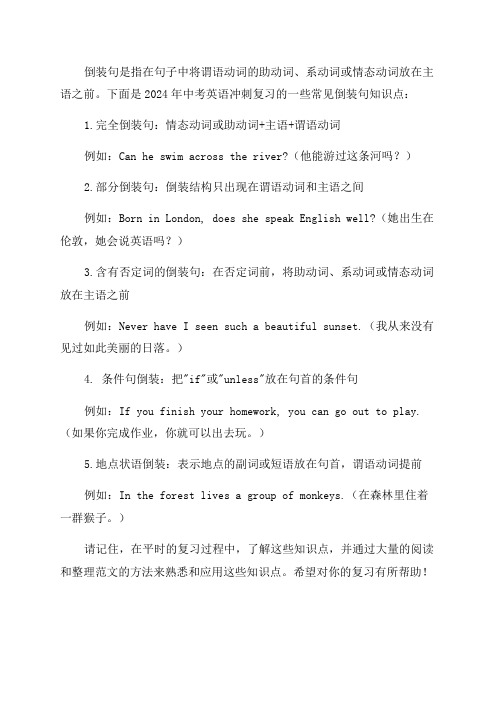
倒装句是指在句子中将谓语动词的助动词、系动词或情态动词放在主语之前。
下面是2024年中考英语冲刺复习的一些常见倒装句知识点:
1.完全倒装句:情态动词或助动词+主语+谓语动词
例如:Can he swim across the river?(他能游过这条河吗?)
2.部分倒装句:倒装结构只出现在谓语动词和主语之间
例如:Born in London, does she speak English well?(她出生在伦敦,她会说英语吗?)
3.含有否定词的倒装句:在否定词前,将助动词、系动词或情态动词放在主语之前
例如:Never have I seen such a beautiful sunset.(我从来没有见过如此美丽的日落。
)
4. 条件句倒装:把"if"或"unless"放在句首的条件句
例如:If you finish your homework, you can go out to play.(如果你完成作业,你就可以出去玩。
)
5.地点状语倒装:表示地点的副词或短语放在句首,谓语动词提前
例如:In the forest lives a group of monkeys.(在森林里住着一群猴子。
)
请记住,在平时的复习过程中,了解这些知识点,并通过大量的阅读和整理范文的方法来熟悉和应用这些知识点。
希望对你的复习有所帮助!。
2024年中考英语冲刺复习知识点倒装句

倒装句是英语语法中的一种句子结构,常见于以下几种情况:
1.以副词或介词开头的倒装句:
- Never have I seen such a beautiful sunset.
- Under no circumstances should you go there.
2.以否定词开头的倒装句:
- Not only does she speak fluent English, but she also speaks French.
3.在条件状语从句中的倒装句:
- Should you need any assistance, feel free to ask.
4.一些表示地点和方向的介词短语前置时的倒装句:
- Upstairs sat a man, staring out of the window.
5. 在以“so+形容词/副词”开头表示程度的倒装句:
- So tall was he that he had to bend his head to go through the door.
6.表示部分否定的否定副词或短语后置时的倒装句:
- He knows nothing of the matter, nor do I.
7. 在以“only+状语”开头的倒装句:
- Only in this way can we solve the problem.
8. 在以“here/there”引导的倒装句:
以上是2024年中考英语冲刺复习的常见倒装句知识点。
通过重点掌握这些句型,可以提高自己的语法能力,更好地应对中考英语考试。
2024年中考英语冲刺复习知识点倒装句
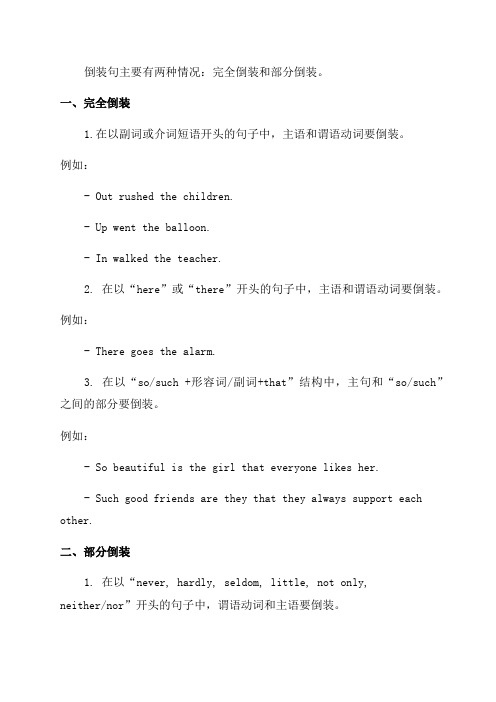
倒装句主要有两种情况:完全倒装和部分倒装。
一、完全倒装1.在以副词或介词短语开头的句子中,主语和谓语动词要倒装。
例如:- Out rushed the children.- Up went the balloon.- In walked the teacher.2. 在以“here”或“there”开头的句子中,主语和谓语动词要倒装。
例如:- There goes the alarm.3. 在以“so/such +形容词/副词+that”结构中,主句和“so/such”之间的部分要倒装。
例如:- So beautiful is the girl that everyone likes her.- Such good friends are they that they always support each other.二、部分倒装1. 在以“never, hardly, seldom, little, not only,neither/nor”开头的句子中,谓语动词和主语要倒装。
例如:- Never have I seen such a beautiful sunset.- Little did she know about his plan.2. 句中含有“only when, not until”等连词短语时,谓语动词和主语要倒装。
例如:- Only when she arrived home did she realize she had left her wallet at the office.- Not until the last minute did he find the solution.3. 在以“no sooner than/hardly/scarcely…”开头的句子中,主语和谓语动词要倒装。
例如:- No sooner had she finished her speech than the audience applauded.- Hardly had I started my meal when the phone rang.以上是中考英语冲刺复习的倒装句知识点,希望能对你的学习有所帮助。
2023年初中英语语法之倒装句详解及练习

2023年初中英语语法之倒装句详解及练习倒装句概念解析一. 定义主语在谓语之后则称为倒装语序(Inverted Order),为了强调、突出等语的目的而颠倒原有语序的句式叫做倒装句。
在倒装句中,颠倒了的成分可以恢复原位而句意基本不变,句法成分不变。
二. 类型1、全部倒装谓语动词提前至主语之前为全部倒装。
eg.There was a drop in the temperature.2、部分倒装助动词或情态动词提至主语之前,谓语动词位置不变,即为部分倒装。
eg. Must you arrive here at 10 am.3、否定词提前倒装,否定词用于句首时,句子应进行部分倒装。
否定词常用的有:Not only…(but also),Not until(直到…..才),No sooner….(than)(一…..就),Never/ Rarely/Seldom,Hardly/Scarcely,Few/Little,Neither/Nor (也不),At no time,Under no circumstances(决不),On no account (决不),In no way,其中not only, no sooner, hardly, scarcely 分别和but (also), than, when搭配使用.eg. No sooner had I arrived school than it began to rain.4、副词提前倒装副词提至句首引起倒装,可分以下几种情况:only + 副词(when, before, if, after等)或only+介词状语(由in, under, by, on, after等引导)提前,必须部分倒装。
eg. Only in this way can you solve the problem.often, such, so等副词提前,部分倒装。
注意,so的另一种倒装是表示“也…”eg. California relies heavily on income from crops, and so does Florida.neither,nor的倒装eg. He can't dance, neither/nor can I.in, out, down, up, away, off, here, there, over等副词提前,全部倒装。
关于中考中的倒装句知识点归纳与总结

关于中考中的倒装句知识点归纳与总结在中考英语考试中,倒装句是一个重要的语法知识点。
掌握倒装句的用法对于学生来说是非常关键的,因为它经常在选择题和填空题中出现。
本文将对中考中的倒装句做一个归纳与总结,帮助学生更好地掌握其用法。
一、倒装句的定义倒装句是指将句子中的主语和谓语动词的语序颠倒过来。
一般而言,在肯定句中,只有在特定情况下才会使用倒装句。
二、完全倒装句1. 在以副词here, there或者表示地点的介词短语开头的句子中,主语和谓语动词需要完全倒装。
例子:There is a book on the table.(书在桌子上)On the table is a book.(桌子上有一本书)2. 在以表示方向的副词开头的句子中,主语和谓语动词需要完全倒装。
例子:Down the street ran the little boy.(小男孩沿着街道跑去了)Up the hill walked the old man.(老人走上了山坡)3. 在以表示否定意义的副词或短语开头的句子中,主语和谓语动词需要完全倒装。
例子:Never have I been to Paris.(我从未去过巴黎)Not only does he play basketball, but he also swims.(他不仅打篮球,而且游泳)三、部分倒装句在特定情况下,也可以使用部分倒装句。
部分倒装句是指将助动词或情态动词与主语调换位置,而谓语动词保持不变。
1. 在以表示否定意义的副词或短语放在句首时,用部分倒装。
例子:Never have I seen such a beautiful sunset.(我从未见过如此美丽的日落)Not until today did I realize the importance of hard work.(直到今天我才意识到努力的重要性)2. 在以so或neither开头的句子中,也需要使用部分倒装。
中考英语倒装句解题技巧讲解及练习题(含答案)

中考英语倒装句解题技巧讲解及练习题(含答案)一、倒装句1.–I usually go hiking with my friends.-- ____do I.A. NorB. SoC. Neither【答案】 B【解析】【分析】句意:一一我经常和朋发一起去徒步旅行。
一一我也是。
肯定句后跟”so+谓语+主语“,表示某人某物也……;否定句后跟"Neither/Nor+谓语+主语”,表示某人某物也不……。
本题前句是肯定句,故选B。
2.—Zhou Ming likes reading English magazines.—_______. It's good for English learning.A. So do IB. So am IC. So I do【答案】 A【解析】【分析】句意为:—周明喜欢读英语杂志。
—我也是。
这对英语学习由好处。
So+助动词+主语,完全倒装,表示“.......也......”。
故选A。
【点评】考查倒装句3.—More and more people prefer to walk rather than ride in cars.—________. Walking is good for health.A. So they areB. So are theyC. So they doD. So do they【答案】 C【解析】【分析】句意:——越来越多的人比起开车更喜欢走路。
——确实如此,走路对健康有好处。
A他们也是,B是啊,C是啊,D他们也是。
根据 Walking is good for health,可知表示确实是这样,起强调作用,用so+主语+助动词,因此排除B和D;再根据谓语prefer,实义动词,和主语people可知,应用助动词do,故选C。
【点评】考查倒装句,注意理解倒装句so do they和陈述句so they do的意义及用法区别。
2020中考英语复习--倒装句专项讲解和练习题(附答案)
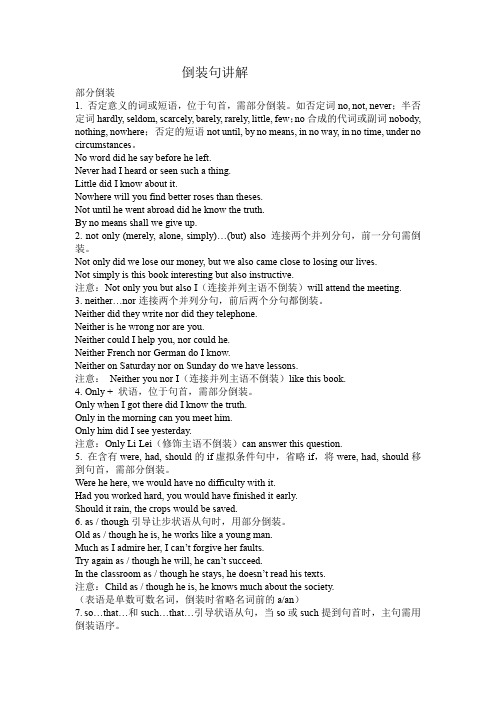
倒装句讲解部分倒装1. 否定意义的词或短语,位于句首,需部分倒装。
如否定词no, not, never;半否定词hardly, seldom, scarcely, barely, rarely, little, few;no合成的代词或副词nobody, nothing, nowhere;否定的短语not until, by no means, in no way, in no time, under no circumstances。
No word did he say before he left.Never had I heard or seen such a thing.Little did I know about it.Nowhere will you find better roses than theses.Not until he went abroad did he know the truth.By no means shall we give up.2. not only (merely, alone, simply)…(but) also 连接两个并列分句,前一分句需倒装。
Not only did we lose our money, but we also came close to losing our lives.Not simply is this book interesting but also instructive.注意:Not only you but also I(连接并列主语不倒装)will attend the meeting.3. neither…nor连接两个并列分句,前后两个分句都倒装。
Neither did they write nor did they telephone.Neither is he wrong nor are you.Neither could I help you, nor could he.Neither French nor German do I know.Neither on Saturday nor on Sunday do we have lessons.注意:Neither you nor I(连接并列主语不倒装)like this book.4. Only + 状语,位于句首,需部分倒装。
中考一轮复习语法必考点精讲精练---倒装句和主谓一致
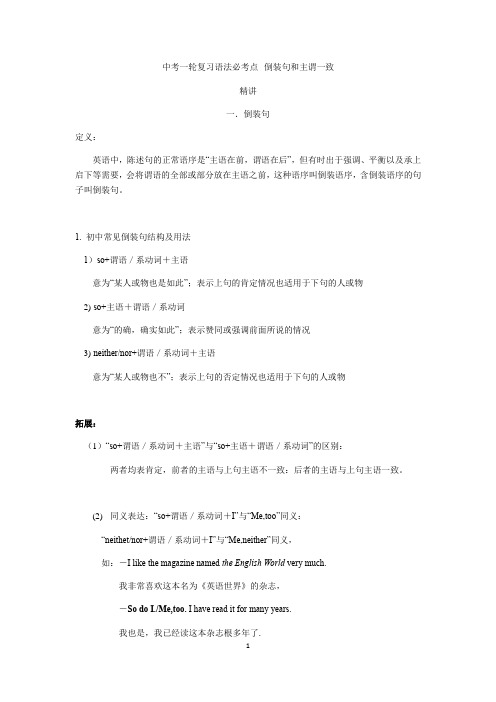
中考一轮复习语法必考点--倒装句和主谓一致精讲一.倒装句定义:英语中,陈述句的正常语序是“主语在前,谓语在后”,但有时出于强调、平衡以及承上启下等需要,会将谓语的全部或部分放在主语之前,这种语序叫倒装语序,含倒装语序的句子叫倒装句。
1. 初中常见倒装句结构及用法1)so+谓语/系动词+主语意为“某人或物也是如此”;表示上句的肯定情况也适用于下句的人或物2)so+主语+谓语/系动词意为“的确,确实如此”;表示赞同或强调前面所说的情况3)neither/nor+谓语/系动词+主语意为“某人或物也不”;表示上句的否定情况也适用于下句的人或物拓展:(1)“so+谓语/系动词+主语”与“so+主语+谓语/系动词”的区别:两者均表肯定,前者的主语与上句主语不一致:后者的主语与上句主语一致。
(2)同义表达:“so+谓语/系动词+I”与“Me,too”同义:“neithet/nor+谓语/系动词+I”与“Me,neither”同义,如:-I like the magazine named the English World very much.我非常喜欢这本名为《英语世界》的杂志,-So do I./Me,too. I have read it for many years.我也是,我已经读这本杂志根多年了.(3)谓语的形式:须根据上句时态,句型的变化而变化,如:-When I was five,I drew very well.当我5岁时,我绘画很好。
-So did I.我也一样。
【上句是肯定情况,下句须选so:上句中叙述的事发生在过去,下句须用一般过去时:上句中主句的谓语动词drew为实义动词,下句须用助动词did】二.There be 结构定义:英语中,There be结构为“There be+主语+其他”,表示“某地或某时有. . . . ”,其中,There无实际意义,be须与后面邻近的主语和时间状语在数和时态上保持一致。
2024年中考英语倒装句详细讲解和讲义

2024英语中考倒装句详细讲解和讲义一、倒装句定义:英语中的倒装语序是一种语法结构,用于强调某些信息、改变语气或满足特定的语言要求。
在英语中,倒装语序有以下几种形式:二、倒装句种类:1.完全倒装:将助动词或情态动词放在主语之前,形成完全倒装。
例如:He is going to the party. →Is he going to the party?They have finished their work. →Have they finished their work?2.部分倒装:将助动词或情态动词与主语之间颠倒顺序,形成部分倒装。
常见的情况包括:否定词位于句首时:Never have I seen such a beautiful sunset.表示地点或方向的介词短语置于句首时:Up the hill ran the children.only 和so 位于句首时:Only when the rain stops will we go for a walk. So beautiful was the sunset that it took my breath away.3.倒装问句:将助动词或情态动词放在句首,形成倒装问句。
例如:Are you going to the party?Can she swim?三、中考常见的倒装句型:1.There be句型的倒装句的具体讲解:定义:"There be" 句型是用来表达存在或出现某人或某物的句子结构。
在倒装语序中,当使用"there be" 句型时,主语"there" 和动词"be" 的顺序被颠倒,即形成了倒装句。
具体讲解如下:(1)肯定句的倒装:在肯定句中,当使用"there be" 句型时,主语"there" 和动词"be" 需要颠倒位置。
中考英语热门考点《倒装句》知识点精讲归纳+例句分析
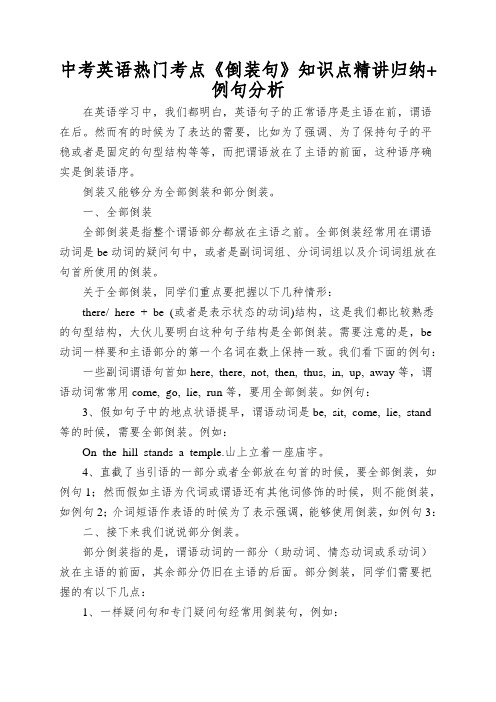
中考英语热门考点《倒装句》知识点精讲归纳+例句分析在英语学习中,我们都明白,英语句子的正常语序是主语在前,谓语在后。
然而有的时候为了表达的需要,比如为了强调、为了保持句子的平稳或者是固定的句型结构等等,而把谓语放在了主语的前面,这种语序确实是倒装语序。
倒装又能够分为全部倒装和部分倒装。
一、全部倒装全部倒装是指整个谓语部分都放在主语之前。
全部倒装经常用在谓语动词是be动词的疑问句中,或者是副词词组、分词词组以及介词词组放在句首所使用的倒装。
关于全部倒装,同学们重点要把握以下几种情形:there/ here + be (或者是表示状态的动词)结构,这是我们都比较熟悉的句型结构,大伙儿要明白这种句子结构是全部倒装。
需要注意的是,be 动词一样要和主语部分的第一个名词在数上保持一致。
我们看下面的例句:一些副词谓语句首如here, there, not, then, thus, in, up, away等,谓语动词常常用come, go, lie, run等,要用全部倒装。
如例句:3、假如句子中的地点状语提早,谓语动词是be, sit, come, lie, stand 等的时候,需要全部倒装。
例如:On the hill stands a temple.山上立着一座庙宇。
4、直截了当引语的一部分或者全部放在句首的时候,要全部倒装,如例句1;然而假如主语为代词或谓语还有其他词修饰的时候,则不能倒装,如例句2;介词短语作表语的时候为了表示强调,能够使用倒装,如例句3:二、接下来我们说说部分倒装。
部分倒装指的是,谓语动词的一部分(助动词、情态动词或系动词)放在主语的前面,其余部分仍旧在主语的后面。
部分倒装,同学们需要把握的有以下几点:1、一样疑问句和专门疑问句经常用倒装句,例如:2、以so, neither, nor开头的句子,前一句表示的确信过否定的情形也适合另一个人或事物的时候,要倒装,大伙儿看下面的句子明白得体会:never等具有否定意义或者否定形式的词或词组位于句首的时候,用倒装;不位于句首的时候则用正常语序。
- 1、下载文档前请自行甄别文档内容的完整性,平台不提供额外的编辑、内容补充、找答案等附加服务。
- 2、"仅部分预览"的文档,不可在线预览部分如存在完整性等问题,可反馈申请退款(可完整预览的文档不适用该条件!)。
- 3、如文档侵犯您的权益,请联系客服反馈,我们会尽快为您处理(人工客服工作时间:9:00-18:30)。
中考英语| 倒装句考点详解与精练英语句子的正常语序是主语在前,谓语在后。
但是有的时候为了表达的需要,把谓语放在主语的前面即“谓语(或谓语一部分)+主语”,这种语序就是倒装语序。
部分倒装1. 否定副词位于句首时的倒装在正式文体中,never, seldom, rarely, little, hardly, scarcely, no sooner, no longer, nowhere 等含有否定意义的副词若位于句首,则其后要用部分倒装:I shall never forgive him.Never shall I forgive him.我永远不会宽恕他。
He seldom goes out for dinner.Seldom does he go out for dinner.他很少出去吃饭。
She hardly has time to listen to music.Hardly does she have time to listen to music.她几乎没时间听音乐。
注意:(1) 对于not…until句型,当not until…位于句首时,其后的主句要用倒装语序:He didn't leave the room until the rain stopped.Not until the rain stopped did he leave the room.雨停了之后他才离开这房间。
(2) 某些起副词作用的介词短语,由于含有否定词,若位于句首,其后要用部分倒装:On no accounts must this switch be touched.这个开关是绝不能触摸的。
2.“only+状语”位于句首时的倒装当一个状语受副词only的修饰且置于句首时,其后用部分倒装语序:Only then did he realize that he was wrong.到那时他才意识到他错了。
Only in this way are you able to do it well.你只有用这种方法才能把它做好。
Only when he returned home did he realize what had happened.当他回到家里时,才知道出了什么事。
3.“so+助动词+主语”的倒装当要表示前面提出的某一肯定的情况也同样适合于后者,通常就要用“So+助动词+主语”这种倒装结构:You are young, and so am I. 你年轻,我也年轻。
She likes music, and so do I. 她喜欢音乐,我也喜欢。
If he can do it, so can I. 要是他能做此事,我也能。
注意:(1) 若前面提出某一否定的情况,要表示后者也属于同样的否定情况,则应将其中的so改为neither或nor:You aren’t young and neither am I. 你不年轻,我也不年轻。
She hasn’t read it and nor have I. 她没有读它,我也没有读。
(2) 注意该结构与表示强调或同意的“so+主语+be动词或助动词”结构的区别:"It was cold yesterday." "So it was." “昨天很冷。
”“的确很冷。
”"Father, you promised." "Well, so I did." “爸爸,你答应过的。
”“嗯,是答应过。
”4. 由“not only…but also”引出的倒装当not only…but a lso位于句首引出句子时,not only 后的句子通常用部分倒装形式:Not only is he a teacher, but he is also a poet.他不仅是一位教师,而且是一位诗人。
Not only did he speak more correctly, but he spoke more easily.不仅他讲得更正确,也讲得更不费劲了。
全部倒装1.here 和there位于句首时的倒装表示地点的here和there位于句首时,其后用完全倒装形式。
这类倒装句的谓语通常是动词be和come, go等表示移动或动态的不及物动词:Here's Tom. 汤姆在这里。
There's Jim. 吉姆在那儿。
Here comes the bus. 公共汽车来了。
There goes the bell. 铃响了。
There goes the last train. 最后一班火车开走了。
注意:(1)若主语为代词,则不倒装:Here I am. 我在这儿。
/ 我来了。
Here it comes. 它来了。
(2)其中的动词有时也可能是stand, lie, live等表示状态的动词(表示存在):There stood a desk against the wall.靠墙放着一张书桌。
Once upon a time, there lived a man known by the name of Beef.从前有个人名叫比夫。
2. 状语或表语位于句首时的倒装为了保持句子平衡或使上下文衔接紧密,有时可将状语或表语置于句首,句中主语和谓语完全倒装:Among these people was his friend Jim.他的朋友吉姆就在这些人当中。
By the window sat a young man with a magazine in his hand.窗户边坐着一个年轻人,手里拿着一本杂志。
注意:在表语置于句首的这类倒装结构中,要注意其中的谓语应与其后的主语保持一致,而不是与位于句首的表语保持一致。
比较:In the box was a cat. 箱子里是一只猫。
In the box were some cats. 箱子里是一些猫。
练一练1.—Tara has made great progress in English this term.—_______, and ________.A. So she has; so have youB. So she has; so you haveC. So has she; so you haveD. So has she; so have you【答案】 A【解析】塔拉这学期的英语取得了很大的进步。
她的进步的确大,你的也不小。
so,位于分句或句子的开头,这种结构通常表示前面所说的情况也适合于另一个人(或事物),表示“我也这样”之类的概念。
其句型可归纳为:so + be / have / 助动词/ 情态动词+ 主语。
如果第二分句只是重复前句的意思,用来表示赞同时,so之后的主语和谓语就不能颠倒。
so,开头的倒装句一定要与上句的时态保持一致。
so开头的倒装句中的助动词或情态动词要根据人称的变化而变换。
所以选A。
2.— I think the plan is just a waste of time. What do you think?— Well, if you don't support the plan, ________.A. neither do IB. so do IC. neither will ID. so will I【答案】 C【解析】句意:——我认为这个计划只是在浪费时间。
您是怎么想的?——好,如果你不支持这个计划,我也不支持。
Neither+助动词+主语,表示主语也不是……;这里是if引导的条件状语从句,主句用一般将来时,从句用一般现在时态,这里是主句,故助动词用will。
根据题意,故选C。
考查倒装句,注意Neither+助动词+主语,表示主语也不是这样;so+助动词+主语,表示主语也是这样。
3.If you go to his party tomorrow,________.A. won't, neither do IB. don't, neither will IC. don't, neither do ID. /, so do I【答案】 B【解析】句意:如果你明天不参加他的聚会,我也不去。
分析:考查if引导的条件状语从句,通过时间状语tomorrow体现时间是将来时,因此从句用一般现在时,主语是第二人称用do; 我也不去,为主句,同时前句为否定形式,因此用neither,故选B。
4.—Oh, my god! Recently I have put on 5 pounds.—______. I think I should lose weight.A. So do IB. So have IC. Neither do ID. Neither have I【答案】 B【解析】句意:—啊,我的天呀!最近我长胖了五磅。
—我也是,我认为我应该减减肥了。
so +主语+助动词/情态动词/系动词:某某确实如此,主语与上文是同一人。
So+助动词/情态动词/系动词+主语:某某也如此,主语与上文不是同一人,表示后者适合前者。
上文是否定句,下文表示某某也不,用neither +助动词+主语。
这些句式在时态上与前一个句子相同。
根据上句是肯定句,现在完成时态,主语与上句不同,故选B。
5.—I didn't go to the cinema yesterday. What about you?—____________, because I was preparing for the project all the time.A. Nor do IB. Neither did IC. Neither am ID. Nor was I【答案】 B【解析】句意:—我昨天没有去电影院,你呢?—我也没去,因为我一直在准备这个项目。
根据句意及题干分析此题是过去也没去,所以选B。
6.—Listen! .—Oh, let's go to the classroom.____________.A. There goes the bellB. There's the bellC. There the bell goesD. The bell goes there【答案】 A【解析】句意:---听,铃响了。
---哦,咱们去教室吧。
There goes the bell.是倒装句,相当于“The bell is ringing。
”故答案为A。
7.—He was late for the meeting.—___________A. So I wasB. So was IC. So I didD. So did I【答案】 B【解析】句意:本题考查“So+助动词/be动词/情态动词+主语”和“So+主语+助动词”二种结构的用法区别。
